By JULIA COOKE
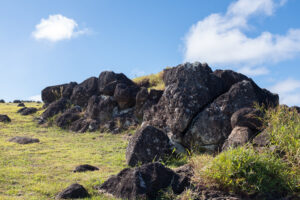
The morning was clear and the colors vivid: yellow brush, white ocean froth against cobalt sky. In front of me, dense gray volcanic stone appeared to consume the light. I stood in salty mist before an altar on the north coast of Rapa Nui, Easter Island. A single toppled moai lay in violent chunks on the ground. At 9:00 a.m. the sun still hovered tight at the horizon. Rapa Nui, which is part of Chile 2,300 miles away, is kept closer to mainland time than by geographical rights it should be. The sun rises gray and sticky at 8:30 in the morning, and sets late, too. This is not the only disorienting thing about Rapa Nui, but rather the most objective example.
One dark night, I’d watched a horse sleeping in the street outside of my hotel, stark upright in a white cone of drizzle that extended from the streetlight. A car crept down the street and honked; the horse did not move. After a few minutes the car drove up and onto the grass beside the horse, sweeping its tail aside, nearly bumping its rump. The horse flicked its tail back into place and still slept. All across the island, the stripped wood fenceposts bordering pastures lacked wire to link them; where one pasture ended and another began was unclear. Rainstorms assembled overhead and cracked the sky in a sixty-second period and then disappeared just as quickly. And the moai—pronounced “moe-aye”—the enormous, human-shaped megaliths which are the real reason anyone goes to Rapa Nui, disoriented most of all: shockingly plentiful, lurid in their casual proximity, upright or smashed on the ground, resolutely resistant to simple interpretation.
Individually, the moai impressed. They average thirteen feet high, twelve tons—twice the weight of an elephant, seven times as heavy as a car—and were sculpted with minimal tools by people who lived in complete isolation on the most remote inhabited island on earth, erected no one knows how. No consensus among archaeologists tells us how the islanders moved them across miles of hilly terrain or stood them upright atop some three hundred altars. The largest moai weighs eighty-six tons, and they number nearly nine hundred across an island of sixty-three square miles. In person, the sheer plenitude astonishes: moai in a town square, at a port, in the dozens at the quarry, crumbled along a road, upright in rows. Each has a lifted chin, pressed-together lips, a potbelly, and a facial expression somewhere on a spectrum from dour to regal. Together, with more than three in a row, the disparity in their sizes gives them an almost toothy look. The collective impression is one of an enormous grin.
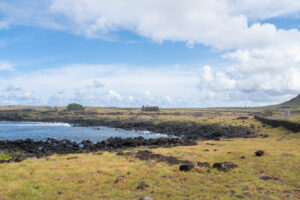
That last morning, my husband and I had been driving just after sunrise toward the quarry where the moai had all been made. We had already visited ten or so archaeological sites. Now we passed altar after minor altar until my husband silently pulled the car off the road at what seemed like random—a cluster of rocks on a slightly raised plinth that looked especially picturesque between a pasture and the surf. Once it would have held an upright moai; now the altar appeared to be a mere pile of rubble, chunks of a sculpted minor moai toppled and broken long ago.
As I walked across the field between road and oceanside altar, I saw glints in the soil, a faint iridescence. I learned later that I had probably walked right across obsidian spearheads.
I walked in a loop around the altar and the crushed and fallen moai alongside it, examining an enormous face cracked clear through, just below a nose the size of my thigh; then down closer to the water to look at a reddish chunk of sculpted rock, once a topknot hat that would have sat on the head of the upright moai. It had landed farther from the sculpture’s head and rolled, probably. I bent and leaned toward it and the tufts of grass growing alongside it.
“Whoa,” my husband said to me, suddenly, raising his arm to point back up the cliff of spiky volcanic rocks. “Are they actually standing on the altar?”
I looked up and saw another couple. Indeed, they stood atop the altar, gazing out at the water. “Hey!” my husband called out. “That’s a ruin!”
They turned their faces toward us—we must have been a hundred meters away—and then turned back, stayed right where they were. Suddenly I was screaming. Blood in my cheeks, making a spectacle, shouting about religious relics and archaeology, calling them faltarespetos—respect-lackers, a real insult in some circles. Still I continued, regrettably: Couldn’t they read, and even if they couldn’t read, couldn’t they understand the cartoonish drawings with the big red X over the stick drawing of a statue? What was wrong with them?
The man turned toward me. Heavy-set, polo tight across his chest. For a moment his body looked poised to stride. Then the man shrugged, turned back around, and a few moments later, he shuffled off the altar and into the grass.
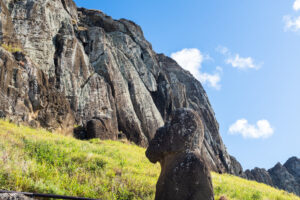
I didn’t know it then, but the man and I had taken opposing roles in a familiar morality play that’s been enacted around the subject of Rapa Nui for the last decade and a half. Across the island and around the world, scholars and journalists and politicians and tourists and locals debate exactly what kind of protection the ruins of Rapa Nui need, from whom, and how.
Rapa Nui is young relative to the numinous, megalithic archaeological sites of the world. Stonehenge, the Egyptian pyramids, Göbekli Tepe: all believed to have been constructed thousands of years before the birth of Christ. Rapa Nui, in contrast, was settled by Polynesian explorers in wooden canoes in the much more recent past.
Since about 2000 B.C., Polynesians had been fanning out across the islands of Oceania in canoes equipped with livestock, crops, house builders, toolmakers, carvers, priests, women of childbearing age.1 Each boat held a complete society. Sometime between 980 and 1280 A.D., a canoe or two found Rapa Nui.
The Polynesian explorers arrived on a fecund island composed of three low volcanic peaks with hammocks of arable earth stretched between them. It was small but habitable, and lush with palms, the sky reeling with wings—twenty-six species of seabirds lived on the island, and one species of land bird. Now two: the Polynesians had brought with them chickens. They had brought sweet potato and taro, gourds and sugar cane, drinking water and a stowaway, a species of small rat. They established a colony, made homes and children and religious artifacts and political systems. Families divided the island into parcels overseen by different clans. Each clan cobbled altars of rocks fitted neatly together, and on them they placed the moai. Representations of ancestors, keepers of “mana,” divine power, the moai faced in from the ocean toward the human settlements on land.
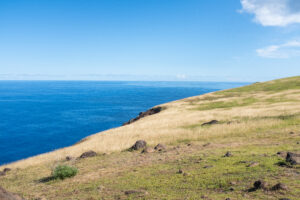
Few contest what the moai represented or how they functioned within society (except those who believe that the megaliths are evidence of aliens’ onetime presence on Earth). It’s the environment on the island itself, combined with the presence of the moai, that poses the interpretive challenge to contemporary scholars.
The moai impressed the first Europeans who landed on the island, too. By the time that first boat arrived, the Rapa Nui had sculpted and erected hundreds of colossal stone statues. The land had changed drastically: the island contained no more trees, but it did proffer “a great abundance” of fruit, root vegetables, and poultry for the sailors’ consumption. “At first, these stone figures caused us to be filled with wonder, for we could not understand how it was possible that people who are destitute of heavy or thick timber, and also of stout cordage, out of which to construct gear, had been able to erect them,” Captain Jacob Roggeveen wrote in his captain’s log. He had arrived on Easter Sunday, 1722. The Dutch sailors investigated the island, inhabited by some three thousand people, they guessed, for a day, before moving on.
The next ship of Europeans, Spaniards, arrived in 1770. Again they were impressed: enormous statues, no machinery, no wood. Captain James Cook and his crew came through four years later. He noted a desolate landscape. Fifty more boats came through by 1862—missionaries, New England whalers, international explorers—though the total number is nearly certainly higher than those recorded.2 The island population had risen and fallen in the past one and a half centuries, as new diseases had rippled through along with the sailors. That year, 1862, Peruvian slave raiders recorded three thousand inhabitants and then took half of them. Within fifteen years, after the few survivors of a smallpox epidemic in the Peruvian slave colony had been returned to the island, the population had been reduced to just over one hundred living Rapa Nui.
In the early 1860s, one of the Catholic missionaries on the island noticed a written script on tablets and other objects in the houses. By the time Westerners wanted to learn what these glyphs meant, though, most of the people who knew how to read them had died of smallpox. Today, no one knows exactly when the script originated or what its symbols mean. It is the only known script native to Polynesia. The lyrical symbols, called the rongorongo script, appear on tablets whose wood was traced back to a European oar, most likely from a cross erected by missionaries. Without understanding this written text, all that an outsider could learn about the Rapa Nui people winnowed down to what could be transmitted in the storytelling of some one hundred humans.
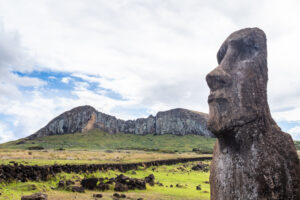
By the mid-twentieth century, two Rapa Nui mysteries tantalized across scholarship and pop culture. The moai and the rongorongo appeared in comic books from DC, Marvel, and Disney,3 on the cover of a Pink Floyd album, in a terrible Kevin Costner movie. The moai magnetized academics and tourists like my husband and myself, though it was only when I got back and found myself mildly obsessed with the island that I identified my own visit as part of a distinct trend. It had been my husband’s choice of destination, not mine. Yet I could not stop thinking about it, reading about it, and remembering the senses ignited there.
In the last twenty years, amid the pop culture and the scholarship, the ecology of the physical landscape and the archaeological remnants within it, two contrary storylines about Rapa Nui’s pre-European history have emerged. One of them is the story espoused by UCLA geography professor and popular-science writer Jared Diamond in his 2005 bestseller Collapse: How Societies Choose to Fail or Succeed. As he tells it, from those first canoes of Polynesians the population grew. Each chiefdom made similar moai, which required wood to make and move into place. The population grew to twenty thousand. When the trees ran out, so did other resources; hunger spread, clans warred. People killed each other with obsidian spearheads so plentiful that they now litter the landscape by the thousands. A new religion arose, a cult worshipping a half-bird, half-man, and the moai were toppled. Violence, clan warfare, cannibalism proliferated; a yearly “birdman competition” pitted men in a sort of high-stakes triathlon that involved swimming shark-studded waters. The Europeans recorded diminishing numbers of locals. The Rapa Nui had devised their own destruction.
In the last decade and a half, research papers have come out every year or two in support or rejection of Diamond’s hypothesis, each round accompanied by headlines that proclaim the EASTER ISLAND MYSTERY SOLVED. Diamond’s diagnosis, itself based on that of two European archaeologists, no longer appears definitive. Deforestation, the heavy, rocky fields still visible across the island, could have been intentional and entirely separate from moai construction, one round of papers posited. Rock gardens, argued one research team, made the environment more, not less, agriculturally productive: lithic mulching kept winds down and moisture in the earth, and increased nutrient levels in the soil.4
A second comprehensive theory emerged. Two researchers out of the University of Hawaii and California State University demonstrated that a team of eighteen people and a rig of ropes could “walk” a statue across a tract of land, and recreated the experiment for an episode of PBS’s Nova.5 The same team examined the shapes of the obsidian spearheads and found the spearheads were multipurpose tools used for farming and daily life.6 They published a book, The Statues that Walked, drawing a sweeping vision of pre-European history in total contrast to the “collapse” hypothesis: a later date of settlement, a much lower population, and palms felled by those stowaway rats. Resource sharing, not warfare, had ruled among the clans, they wrote.
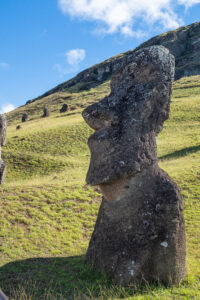
Other papers complicate any conclusive reading of the island’s history. An anthropologist analyzed more than three hundred radiocarbon dates from across the island to demonstrate that areas previously thought to have been abandoned before European contact were still being farmed far later.7 A German team looked at the rats-eating-the-trees hypothesis and found it lacking.8 Most recently, an assessment of the tools used to sculpt the moai demonstrated in a journal paper that they’d all come from the same place; whether shared via coercion or collaboration, the materials implied some degree of consistent cooperation among clans. Support for any decisive narrative has frayed as more information accompanies new analyses posited by teams of researchers that now sometimes include local Rapa Nui academics, too.
When we visited in 2018, I’d pushed the idea that, on an island so small, we should see it more or less on foot: walking, biking, as close to the land as we could be. My husband humored this terrible plan for one full day on which we walked sixteen miles before renting a car for the rest of our trip. We hiked from our hotel in town up to Orongo, the village at the top of the island’s crater, the cliffs from which the birdman competition had launched. Along the way we passed a moai in the harbor where fishermen unloaded crates from skiffs, and we jumped over a sign that read Danger Falling Rocks to access a cave with drawings just below the main path. I felt prim—too distracted by the possibility of danger and the sense of transgression to focus on the drawings. The cave was humid and strange. I wanted to go back up to the main path quickly, after sighting a streak of orange on the gray wall of the cave, a trace of the drawing that our guidebook had said would be there. Later, I wondered what it would have been like to return to the cave after a few days of being on Easter Island, after the sensation of intimacy felt more normal than transgressive.
Around the crown of the crater, I stood and looked at the water below, reflecting dappled clouds like a Dalmatian’s spots. A half dozen people stood at intervals around the rim. I wondered, nonsensically, what it would be like to tumble down the greenish rocks. No guardrail denoted where we should or should not stand—it felt as if a mere shimmer separated standing from falling.
At Orongo, the human dwellings were so much a part of the landscape that they felt grown more than built. The walls of interlocking rocks curved with a sensual loveliness. As we walked back down the hill, I saw the day’s only flight from the mainland beginning to bank toward the runway a half mile or so away. The stray dog that’d been leading our way up the climb had finally left us. My feet ached already; I had begun to complain. As the plane and I moved toward more or less the same point of a triangle, dark green bushes obscured the jet and I sprinted across the red path to clear them, as fast as I have ever run. I pulled the plane back into view and watched it breathlessly, ecstatically, traversing the entire width of the island while landing. The island was so small, so significant, and we humans felt very few.
The Rapa Nui called their island Te Pito-te-henua, from the Polynesian words for “land” and “navel.” In English, it translates as “land’s end,” or “the navel of the world,” though those two translations also feel opposed. It is as far as Polynesian explorers ever settled. From the top of the hill at one of the few inland moai sites, Ahu Akivi, right in the center of the island—the navel’s navel, I suppose—I looked out at the ocean. Impossible not to think about the slow process of sinking. At the island’s museum on our first day, I’d been looking at images of how, in the long, long, long term, a volcano sinks into an atoll and then into the ocean. Since then, every time I stood on a slight rise, the thought would jab through: How long until the spot where I stood was underwater? How many thousands of years?
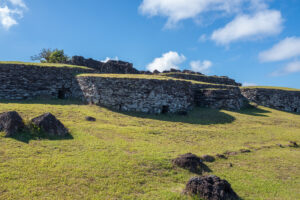
The week before we’d left, I’d seen a New York Times opinion column entitled “A Parable of Self-Destruction,” about Rapa Nui. Within a few months of my return, I’d see another Times feature, now a multimedia undertaking on how vulnerable oceanfront altars and their moai are to rising sea levels: the five- or six-foot rise that some climate change models predict by 2100. If the mystery of the moai had allowed Diamond’s collapse narrative to proliferate, another, newer collapse narrative frames their current vulnerability. Like the mansions on Long Beach and the Vineyard, like Miami and Manhattan, the rising seas of global warming will come for the ahu, the oceanfront altars, first. The water will sweep away the bones buried in some of the altars. It has already begun; bones had washed up onto the fields where I saw horses racing, where I’d walked across glimmering obsidian spearheads.
At Ahu Akivi, seven moai stared out toward sunset. At the spring equinox they’d be oriented perfectly toward the sinking sun; in April, they gazed just to the side of the flinty column of light that stretched across the flat ocean. Here they looked more different than similar. Close up, uniformity shattered. A wider nose here, a weaker chin there, necks thicker or thinner, chests barrel-shaped or mealy-looking, the cant of the head imperious or pensive. Paunches hung differently above their hands, all of whose fingers pointed primly toward one another. None wore pukao, the thirteen-ton red hats balanced on the top of some of the moai. Really, though, for five-hundred-year-old, fifteen-foot megalithic sculptures, they were remarkably expressive.
We were not supposed to be there just then—the parks close at sunset—but had driven up anyway. I’d stepped over the chain that closed the red dirt road. My husband had found a mewling, grey-and-white-striped kitten and cuddled him as we looked around. A man in an official-looking jacket on a motorbike put-putted up the hill. He pulled up just in front of me, the chain-link fence between us, and sat silent, drumming his fingers on the handles. I couldn’t see his eyes behind his sunglasses.
“Buenas tardes,” I said.
He drummed his fingers on the handlebars more. “Is there a guard here?” he finally asked. I shook my head. “I was just looking for one,” I said. My husband pet the kitten. Another ten-second pause.
“I’m the night guard,” he said, and he waved us along the path.
To be there as the sun dipped toward the ocean, not a human in sight, felt like one of those unbelievably fortuitous coincidences that only ever seem to happen far away from home. At the top of the hill, I walked slowly around the seven moai. These moai had been strewn on the ground when Europeans first saw them; now they, like other rows of megaliths, had been set upright, as they would have been in the more distant past. A horse whinnied somewhere in the green behind me. Around the moai, the altar was precise, its rocks organized perfectly. The precision of the moai—their astronomical orientation, their carved lips and pointed fingers, the ahu beneath them—was astounding. Around them I felt a clean sense of gravity.
In the 1960s, just after archaeologists had re-erected the moai at Ahu Akivi, the few tourists who arrived here came to the island clutching copies of ethnographer and adventurer Thor Heyerdahl’s Aku-Aku, Rapa Nui historian and guide Cristián Moreno Pakarati told me. In the 1970s and 1980s they favored a book called Chariots of the Gods?. From the mid-2000s on, he said, most tourists have read Diamond’s Collapse. There has not been another book with enough widespread popularity to eclipse it, even as Rapa Nui scholars like Pakarati and others work with Western researchers on funded projects. Mainstream debates over the island’s history have largely happened in a language that is not theirs, posited by academics with credentials that, until very recently, few if any Rapa Nui had the opportunity to earn.
Each of these popular books is driven by the mystery of how the moai moved from the quarry, where they’d been sculpted, across the island. Heyerdahl, who recorded chunks of the islanders’ oral history, relates how locals told him repeatedly that the statues “walked” into place. With a team of helpers, he tried rocking a mock-up into place, failed, and concluded that they must have used wooden rollers instead. Erich von Däniken, author of Chariots of the Gods?, claims extraterrestrial intervention: the moai were created, he argues, by a small group of aliens stranded on the island, waving to compatriots searching for them from above. Theories rippling through the legitimate scientific community at that time experimented with moving the moai on wooden sleds, with rope pulleys, and in varied combinations of the two.9
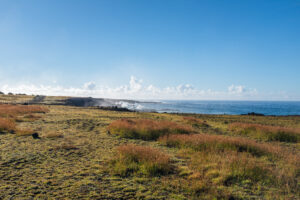
“The collapse narrative started with the first Europeans,” Pakarati told me. The only possible explanation they could conceive for the presence of the moai and the lack of trees was some sort of disaster. And so, he said, “collapse was the hypothesis that drove [the first] archaeologists.”
Indeed, Diamond’s Collapse assumes that massive amounts of wood must have been necessary for moai movement and combines that assumption with cherry-picked segments of oral history, tales of warfare and hunger and cannibalism. In Diamond’s telling, as humans dive perilously toward our collective extinction via climate change, deforestation of the island provides what he calls “chillingly obvious” parallels to modern existence. “The pukao that I saw reminded me of the activities of Hollywood moguls living near my home in Los Angeles,” he writes, “similarly displaying their wealth and power by building ever larger, more elaborate, more ostentatious houses.”10
The publication of The Statues that Walked, which far fewer tourists have read, inspired a flurry of back-and-forth between Diamond and its authors. The competition-and-collapse theory purported the tenuous future of humanity; the cooperation-and-continuity theory defended the dignity and history of the Rapa Nui people.
We left Ahu Akivi and drove into town just before sunset. I wanted to be someplace fixed every evening, to devote all of my attention to the spectacle of sunset, which was always extravagant and imposing: the light became such a presence that it rendered conversation about anything else impossible. The cloudbanks over the ocean were so hefty and solid, with Campari-colored underbellies and bruisy-gray billowing topsides, that it felt as if a whole world might exist in the clouds near the sun. If someone had just then told me there was a fortress in there, structures and people among so many clouds of such dimensions and variation, I would have believed them.
The island’s only town, Hanga Roa, is idyllic in a Jimmy Buffett sort of way: sand slides through the cracks of asphalt roads, beers top the brightly colored tablecloths of open-air restaurants, surfers pock the waves off the bay—Cook’s Bay—and the air is pungent with salt, loam, and diesel. On Sundays, the church bells ring “Ave Maria.” Every restaurant serves its own take on tuna ceviche and coconut rice for a range of tourists who cycle through.
As visitors converge on the waterfront decks of Hanga Roa restaurants at sunset, tourists and locals slip into occasional proximity. Shrill whistles waft from the soccer field just off the bay, where twelve teams fielded from two hundred Rapa Nui men compete in the local league. Bands of children swim in the saltwater pool below one of the restaurants. One evening I watched a naked child, five or so, prance across the small strip of sand just below the restaurant with the two-for-one happy hour. He leaped across the knee-deep water with a pail, singing to himself. A caretaker stood nearby, reaching out every so often toward him. Tourists stood on the deck, handing cell phones to the waitstaff with pleading looks on their faces. Four surfers paddled in the water; the waves rolled low and tight.
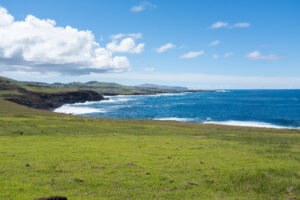
For nearly seventy years, until the 1950s, the surviving Rapa Nui people—a population that had grown to just over seven hundred by then—were restricted to space just outside of Hanga Roa while a Scottish company leased the rest of the island as grazing ground for sheep. In a story that echoes that of indigenous people across the world, a spurious agreement had established Chile’s control in 1888. In the Spanish-language version, the Rapa Nui people ceded sovereignty over the island. The Rapa Nui version, in contrast, cited the Chileans as a “friend of the island.” Neither mentioned any cessation of property titles.11 And yet the Rapa Nui were granted neither Chilean citizenship nor ownership of any of their land until the mid-1960s—nor did they have a court, a police station, or a bank. Since the 1980s, the Rapa Nui Council of Elders has organized itself around the fight for full land rights and occasional referendums for independence even as tourism and an influx of migration to the island strain its capacity.
My sense that we humans were few on Rapa Nui was entirely incorrect. Tourist numbers have risen rapidly. In 2009, the island saw seventy thousand visitors, a stark increase from fourteen thousand in the mid-nineties. Water, electrical, and sanitation infrastructure were stretched; with nowhere to put garbage, piles of trash attracted rodents, dogs, insects. Articles appeared with headlines like “Rapa Nui Déjà Vu: Tourism Threatens to Trigger Another Ecological Collapse.” Local activists shut down the airport for two days, beginning a terse rhythm of protest and crackdown.12 On two separate occasions, the Chilean government sent military police from the mainland to evacuate demonstrators who’d occupied public buildings and parks. When Catalonia held a referendum on independence from Spain in 2017, the mayor of Hanga Roa suggested that Easter Island might have its own vote. “We want the definitive return of our sacred sites—which they call a park,” he told the press. “These are our tombs, there lie our bones!”
A pilfered moai, taken in 1868 as a present for Queen Victoria and on display today at the British Museum, might seem to exemplify the indignity borne by the Rapa Nui. Two years ago, the Chilean government, on behalf of the Rapa Nui, asked the museum to return the moai. It’s an especially important one: as one anthropologist pointed out to me, this particular sculpture, its back carved with images of the birdman, unites two cults that are seen, in the “ecocide” telling of Rapa Nui’s history, to have replaced one another in bloody battle.
A museum spokesperson responded, “The museum is one of the world’s leading lenders and the trustees will always consider loan requests subject to usual conditions.”
As yearly visitors to the island surpassed one hundred thousand in 2016 and residents grew to 7,750—about 2,500 of whom are Rapa Nui—former Chilean president Michelle Bachelet handed control of the national park to a local governing entity in an on-island ceremony. Recent attempts to limit tourism include new laws restricting tourists to thirty days on-island—an okay start, the mayor said, though he would prefer a “total” ban on new residents.
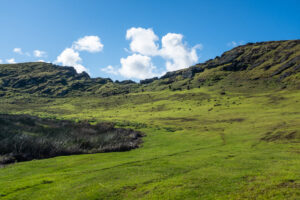
Sweeping social change does not declare itself as such at the outset. In the face of not knowing what will follow the current ecological strains, it makes sense to try to find answers in the past, but what has happened is not always legible, either.
Among the scholars I spoke with—nearly a dozen of the leading voices from universities around the world—the main consensus was a lack of agreement with either the “violent competition and total collapse” or the “peace and collaboration” narrative. Since the 1980s, as the archaeological community began increasingly to question its own Eurocentric assumptions, there has been more and more evidence against collapse, said Christián Pakarati, the Rapa Nui historian and guide. But in less specialized publications like newspaper articles, and in films and even a speech to the United Nations, the neat storyline has persisted. Inconvenient ongoing archaeological analyses are ignored, and similarities to biblical or mythical disasters are elevated. Particularly in the face of the existential crisis of climate change, the temptation to see an easily applicable moral pulls in any stray anecdotes.
Really, all that outsiders have offered to Rapa Nui in response to its mystery is educated conjecture. Right now that conjecture points toward a story somewhere between the two narratives: a population that reached ten thousand, maybe fifteen thousand; then some degree of population decline and a shift in dominant ideology between 1600 and 1800, possibly around decreasing food stock, but very possibly around European arrival. The scholarship is ongoing, which is one of the reasons UC Berkeley anthropologist Patrick Kirch cited for the publication of a new edition of his popular textbook on pre-European Polynesia. “Rapa Nui seems to draw these people—a lot are totally out to lunch, others are okay, others are good—who are all over the map. It draws people who don’t necessarily have a broader background in the Pacific,” Kirch told me. Who don’t necessarily, he continued, have a background in Polynesia, and who apply interpretations honed in European archaeology to a place where the local understanding of history and place is as allegorical as it is factual.
Who, I continued in my head, really want to solve a sexy mystery that’s confounded archaeologists and comic book heroes. Who want to believe that the past is comprehensible because it is past.
“While stories of ancestral places are important to Rapa Nui people, stories of historic places are of equal and, in some cases, greater importance,” writes ethnographer and archaeologist Forrest Wade Young13 of a slight yet important differentiation. The island is cluttered with locations of both ancestral importance—moai, altars, dwellings—and reminders of more recent mistreatment at the hands of Europeans and Chilean colonizers: the beach where Jacob Roggeveen’s crew shot and killed a dozen of the first Rapa Nui they saw, the contemporary homes alongside the remains of the early-twentieth-century leprosy colony the Chilean government ran, and on and on. The stories layer, one on top of another, compressed among a limited number of voices on a very small chunk of land.
The more I thought about it, the more I understood the persistence of tales around collapse to be a failure of metaphor to interpret metaphor. Diamond’s ecocide reading of Rapa Nui relies on the island’s mid-twentieth-century oral history to explain its ancestral archaeological past: the stories of violence and warriors and cannibalism and hunger that were told centuries after the moai’s creation, two hundred years after European “discovery,” one hundred years after near-extinction at colonizers’ hands. Using this oral history, he links the island’s visible and ecological landscape into a clean arc with a potent moral of human foolishness. And that message is easily applicable to present challenges: it is timely.
But stories of violence and warriors and cannibalism and hunger were also narratives of a certain time and place, Pakarati told me. They served their own metaphoric purposes for the people who originally told and listened. Which is not to say that tales of hunger, violence, and cannibalism lacked any factual resonance, he said. Visions of a peace-loving cooperative spread across the island are probably also inaccurate. Rather, the oral history of the island is story, in all its fallibility, responsiveness, and resistance to cohere fully into fact and then recede safely into an established record that stays the same forever.

On that final morning on the island, after shouting at the tourist, we eventually made it to the quarry, our original destination. All of the moai I’d seen—they’d all begun here, sculpted into a hillside volcanic tuff, each shaved down to the outlines of a statue connected to the volcano by a sort of keel and, as artisans had drilled through the keel, disconnected. Then, however it happened, each megalith moved across the island and into place. I pictured all of the different ways they could move, possible or impossible: creeping across the green hills, carried on rollers by humans like ants; swaying back and forth as they walked, connected to the earth by ropes and people; floating, pulled by extraterrestrial magnetism.
Some moai made it to their final destinations, and others were abandoned mid-process. The abandoned were imperfect creations, or moai that had fallen en route and proved impossible to raise, or too big to go anywhere at all, the product of a designer’s overambition. Near the mountain I saw the largest moai ever constructed, seventy-two feet, between 145 and 165 tons—the weight of fifty-odd elephants. Other moai never loosed from the volcano show petroglyphs that depict ships, ghostly outlines of the vessels that brought the Europeans to the island.
From a distance, the grassy volcano, Rano Raraku, had looked almost mossy, an impression amplified by matchstick-like heads poking out of the hillside. Canted at different angles, the moai looked—were—stuck. Or broken, lying facedown along the road in, more and more as I’d approached. Walking on the mottled brown and green hillside felt ruinous.
The intimacy of being among them startled me. I stood in the shade of one and stared up his nostril at the rounded plane, reminding myself that someone had once stood nearly exactly where I stood, maybe to carve that nostril, or under another head inclined so drastically that it felt like a cantilever. Each moai, silted over in the past two or so centuries in different poses, up to a neck or at shoulder level, hinted at its own story but didn’t tell it.
Their grandeur, the sweeping ups and downs of their creation, their movement, and their abandonment told many stories but no single, coherent narrative.
When I returned home, I read and read about Rapa Nui, and I spoke with scholars. I began to feel that, amid the academic rush to definitively establish the island’s archaeological history, many were rapacious, almost rude, ignoring the more recent past and doing little about the present circumstances of the island in order to claim to have deciphered the ancient past.
At first I had wanted to explain, if only to myself, why I loved Rapa Nui as I did. I loved the island’s stateliness and resistance to the arguments and imperatives of the now. But I kept thinking about how an outsider’s drive to understand a place and to find or create personal, circumstantial resonance with it can, like love, be blinding. Powerful, mysterious sites may in our time be accessible to enormous numbers of privileged travelers—tourists, academics—but that doesn’t mean that parallels exist with the present, despite our natural inclinations to seek them. Accessibility generates its own illusions. The anxieties of one era limit interpretation of those past.
I kept thinking about how the Polynesian concept of time has historically differed enormously from the Western construct, which I have always thought of as time-as-salami, sliced and consumed and disappearing. “Contrary to the West’s monochronic concept of time—which is linear and one-way—until only very recently ‘Polynesian time’ was an eternal present,” scholar Steven Roger Fischer wrote. “That is, past and future were always to be adjusted to the here and now.”14
Julia Cooke is the author of Come Fly the World: The Jet-Age Story of the Women of Pan Am and The Other Side of Paradise: Life in the New Cuba. Her essays and reporting have been published in A Public Space, Smithsonian, Tin House, Condé Nast Traveler, and Virginia Quarterly Review, where she is a contributing editor.
Photographs by Patrick Proctor.
Footnotes
1 Steven Roger Fischer, Island at the End of the World: The Turbulent History of Easter Island (London: Reaktion Books, 2005).
2 Ibid.
3 Scott M., “Easter Island Covers,” Seduction of the Indifferent. http://seductionoftheindifferent.blogspot.com/2010/04/easter-island-covers.html.
4 Earthwatch Institute, “Easter Island’s Controversial Collapse: More to the Story than Deforestation?,” ScienceDaily.com, February 18, 2009. And Thegn N. Ladefoged, Christopher M. Stevenson, Sonia Haoa, Mara Mulrooney, Cedric Puleston, Peter M. Vitousek, Oliver A. Chadwick, “Soil Nutrient Analysis of Rapa Nui Gardening,” Archaeology in Oceania 45 (July 2010): 80–85.
5 Nova, “Mystery of Easter Island,” PBS video, 53:10, November 7, 2012, https://www.pbs.org/wgbh/nova/video/mystery-of-easter-island/.
6 Kristin Romey, “Easter Islanders’ Weapons Were Deliberately Not Lethal,” NationalGeographic.com, February 22, 2016.
7 Mara A. Mulrooney, “An Island-Wide Assessment of the Chronology of Settlement and Land Use on Rapa Nui (Easter Island) Based on Radiocarbon Data,” Journal of Archaeological Science 40 (December 2013): 4377–4399.
8 Gunnar Brandt and Agostino Merico, “The Slow Demise of Easter Island: Insights from a Modeling Investigation,” Frontiers in Ecology and Evolution, 27 (February 2015).
9 PBS Online, “Secrets of Easter Island,” https://www.pbs.org/wgbh/nova/easter/move/plan.html.
10 Jared Diamond, Collapse: How Societies Choose to Fail or Succeed (New York: Viking, 2004.
11 Maria Pereyra-Uhrle, “Easter Island Land Law,” The New Zealand Association for Comparative Law, Yearbook 11 (2005): 133–142.
12 Christine Legrand, “Easter Island Issues Chile with Independence Threat,” The Guardian, January 15, 2013.
13 Forrest Wade Young, “’I Hē Koe? Placing Rapa Nui,” The Contemporary Pacific 24 (2012): 1–30.
14 Fischer, Island at the End of the World.



